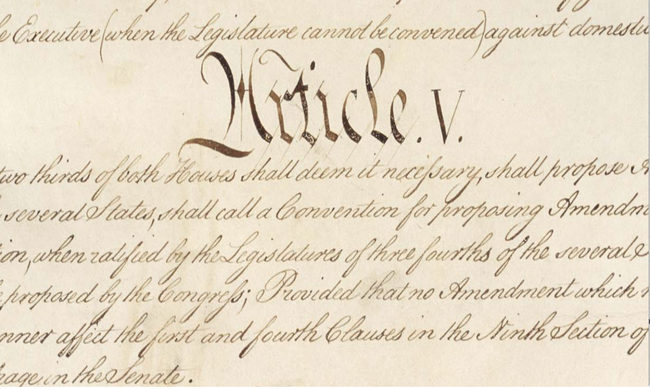This is the third in a series on how the three newest volumes of the Documentary History of the Ratification of the Constitution contribute to our understanding of the Constitution. These new volumes contain Pennsylvania documents not previously published in printed form. (For my first article see here; for the second, here.)
The Constitution requires all amendments to be ratified by three fourths of the states (now 38), but before amendments can be considered for ratification they first must be duly proposed. An amendment can be proposed by (1) two thirds of each house of Congress or (2) a meeting of state delegations the Constitution calls a “Convention for proposing Amendments.”
The state-driven proposal process has not yet been carried to completion, and since the 1960s misinformation about it has been rampant. Liberal opponents of restricting federal power have been particularly active in disseminating this misinformation. This is because as long as the convention process is dormant, Congress is immune from amendments limiting its prerogatives. Aiding the liberal opposition have been a few deeply conservative groups pursuing goals of their own.
Scholarly research over the past decade has fairly well discredited the factual assertions made by the opponents. However, the latest three volumes of the Documentary History of the Ratification contain fragments of information buttressing what we already know. These volumes are not yet online, and I have not reproduced its documents to avoid infringing any copyrights. Accordingly, the following summary includes only citations to specific pages. The citations follow the form “33 DH 45,” which means “Volume 33 of the Documentary History, page 45.”
General and partial conventions.
Some writers misinterpret the Founding-era phrase general convention to mean a convention unlimited as to subject. It actually referred to a convention to which states from all parts of the country were invited. Its antonym was “partial convention,” which referred to a gathering only of states from one or more regions. A convention for proposing amendments is necessarily general, but its agenda may be narrow or broad.
The new volumes contain several examples of how the words “general” and “partial” were used. They are located at—
- 32 DH 44 (an article signed “G.” in the Pittsburgh Gazette, February 17, 1787, contrasting general from partial benefits);
- 32 DH 117 (an August 22, 1787 article signed “Z.” in the Philadelphia Freeman’s Journal, decrying the fact that all Pennsylvania convention delegates came from Philadelphia, and therefore representation was “partial”);
- 32 DH 300 (an article in the Pennsylvania Packet signed “A Citizen of Pennsylvania” and dated October 12, 1787, stating that the Annapolis convention, at which only five mid-Atlantic states were represented, was not a general convention.
The term “convention of the states”.
Opponents have claimed that a convention for proposing amendments is not a convention of the states and that the latter term is of modern coinage. Records from the Founding era show, however, that the term “convention of the states” was applied to interstate gatherings as early as the 1780s, and that a convention for proposing amendments was expected to be that kind of gathering. In 1831 the U.S. Supreme Court approved this characterization.
The new volumes contain two additional examples of the term “convention of the states”—in this case referring to the 1787 constitutional convention, which was but one of many conventions of states held during the founding era. One reference appears in an October 20, 1787 letter from Miers Fisher to Robert Barclay, 32 DH 425, and the other in a March 5, 1788 article by “J.H.” in the Pennsylvania Gazette. 34 DH 988.
The claim that the constitutional convention exceeded its power.
Two common, but false, claims are (1) Congress called the constitutional convention for the limited purpose of proposing amendments to the Articles of Confederation and (2) the delegates exceeded their powers. Both of these claims originated in anti-federalist attacks on the convention delegates. The new volumes of the Documentary History include several examples of this charge in anti-federalist literature: 32 DH 460 (claiming the Pennsylvania delegates exceeded their commission, but apparently misreading the commission); 33 DH 575-76 (claiming the convention violated limits set by Congress).
In fact, the convention was called by Virginia, not by Congress, for the broad purpose of recommending changes in the “foederal constitution” (at the time the word “constitution” generally referred to the entire political system). The Articles were a sort of treaty arrangement akin to NATO today, and treaty signatories always retained the right to negotiate among themselves for rescission of the treaty. Several documents in the new volumes confirm this, including one referring to the Articles as a treaty organization and one explaining that Virginia called the convention for broader purposes outside that framework.
- 32 DH 300 (an October 12, 1787 article in the Pennsylvania Packet pointing out that the proceedings were held outside the framework of the Articles, but were not inconsistent with the Articles) & 32 DH 304 (describing the Articles as “a compact among thirteen states in the nature of a perpetual treaty”).
- 33 DH 475 (an October 27, 1787 article in the Pittsburgh Gazette signed “Hugh H. Brackenridge,” reporting on legislative proceedings; “[T]he calling the late convention did not originate with Congress; it began with the state of Virginia which was followed by this state, without any hint of the necessity of this measure from Congress whatever; it was a proceeding altogether out of the confederation, and with which Congress had nothing to do.”).
- 34 DH 1016 (a letter in the March 12, 1788 Carlisle Gazette pointing out that the commission issued to the Pennsylvania delegates was broad enough to authorize them to do what they did).
A convention sets its own rules and procedures.
Some have argued that Congress as the agency calling an amendments convention can prescribe the convention’s rules and procedures by invoking Congress’s power to pass laws “necessary and proper” for certain purposes. This is flatly erroneous.
Several modern courts have held that neither state legislatures nor Congress may bind conventions through ordinary legislation—and even if Congress could do so in theory, the Necessary and Proper Clause is not broad enough to support such legislation. In addition, if Congress could dictate to the convention, it would undercut the convention’s central purpose of providing a way to bypass Congress.
Congressional dictation also would contradict the traditional prerogative of conventions to establish their own rules. An important document in the new volumes shows that this was understood during the Founding Era. That document is the record of the debate in the Pennsylvania state legislature as reported on by the Pennsylvania Herald on November 14, 1787. The debate addressed the calling of the state convention to ratify (or reject) the Constitution.
The debates shows that all parties agreed that conventions fixed their own rules. George Clymer, who had served as a delegate to the Constitutional Convention, noted that legislative supervision would destroy the very purpose of the convention. Still, one anti-federalist lawmaker proposed that the legislature should at least be able to establish an initial quorum by which the convention could assemble. 33 DH 529-35. His proposal was defeated, according to the Herald, ” by a considerable majority.” 33 DH 536.
Bottom line: Congress has no authority over the convention other than providing in the call for the time and and place of initial meeting and summarizing the topic specified by the state applications.
Opposition to a second convention.
Some opponents cite out of context James Madison’s opposition to immediately holding a second federal convention. They thereby try to communicate that Madison opposed all amendments conventions. This is certainly not true, and I have posted what Madison wrote on the subject so people can see the context for themselves.
These new volumes do not address Madison’s views, but they do show that most of those against a new convention opposed only holding the Constitution in abeyance while a plenipotentiary gathering wrote an entirely new one. Most did not oppose an Article V amendments convention, which Article V limits explicitly to proposing amendments to “this Constitution.” See—
- The January 15, 1788 essay by “Conciliator” in the Philadelphia Independent Gazetteer, 33 DH 792 (objecting to “delaying the adoption of a new government ’till we can have it amended by a previous convention”).
- A January 24, 1788 article by “Conciliator” in the same paper. 33 DH 827-28 (assuming a future convention with power to entirely re-write the Constitution, providing for a new formula for representation in Congress).
- 33 DH 871 (February 9, 1788 letter by John Craighead, fearing a convention with power to write an entirely new document).
The states can control a convention’s agenda.
There is a very common assertion that an amendments convention is free to exceed the agenda set for it by the states. This assertion flies in the face of history and contradicts several important Founding era documents. “Conciliator’s” January 15, 1788 essay also assumes the convention’s agenda is fixed by the scope of the applications from two thirds of the states. This is a necessary premise for his statement, “Yet if only two-thirds should consent to the proposition, they may be made A PART OF THE CONSTITUTION.” 33 DH 790. (In fact, though, “Conciliator” forgot that ratification by three fourths of the states is also required).








